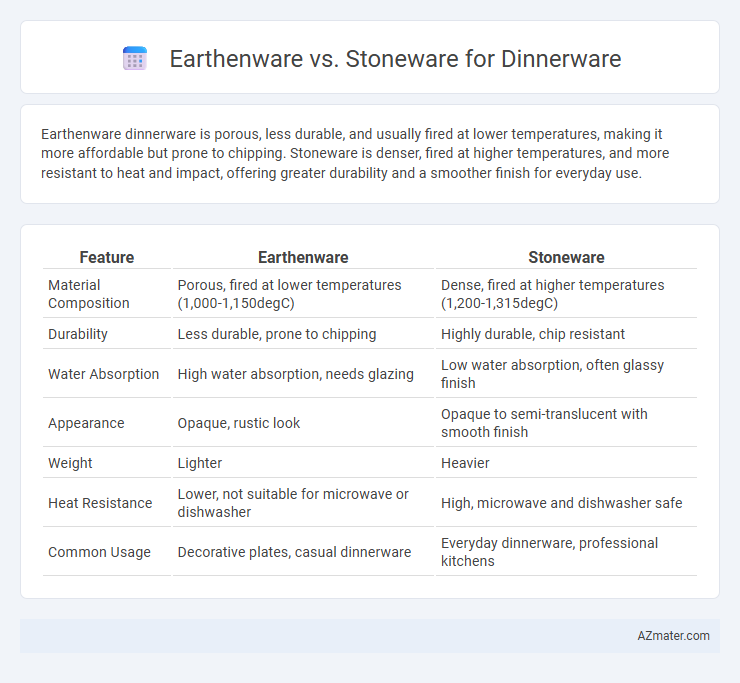Earthenware dinnerware is porous, less durable, and usually fired at lower temperatures, making it more affordable but prone to chipping. Stoneware is denser, fired at higher temperatures, and more resistant to heat and impact, offering greater durability and a smoother finish for everyday use.
Table of Comparison
| Feature | Earthenware | Stoneware |
|---|---|---|
| Material Composition | Porous, fired at lower temperatures (1,000-1,150degC) | Dense, fired at higher temperatures (1,200-1,315degC) |
| Durability | Less durable, prone to chipping | Highly durable, chip resistant |
| Water Absorption | High water absorption, needs glazing | Low water absorption, often glassy finish |
| Appearance | Opaque, rustic look | Opaque to semi-translucent with smooth finish |
| Weight | Lighter | Heavier |
| Heat Resistance | Lower, not suitable for microwave or dishwasher | High, microwave and dishwasher safe |
| Common Usage | Decorative plates, casual dinnerware | Everyday dinnerware, professional kitchens |
Introduction to Earthenware and Stoneware
Earthenware is a type of ceramic fired at lower temperatures between 1,000degC and 1,150degC, known for its porous and slightly brittle nature, making it ideal for decorative pieces and casual dinnerware. Stoneware, fired at higher temperatures ranging from 1,200degC to 1,300degC, offers a dense, durable, and non-porous surface suitable for everyday use and resistant to chipping and cracking. Both materials differ significantly in durability, water absorption, and finishing options, influencing their practicality and aesthetic appeal in dinnerware collections.
Defining Earthenware: Key Characteristics
Earthenware is a type of ceramic known for its porous and coarse texture, typically fired at lower temperatures around 1,000 to 1,150 degrees Celsius. Its rich, earthy tones and rustic appearance make it distinct from stoneware, which is denser and fired at higher temperatures between 1,200 to 1,300 degrees Celsius. Earthenware's relatively low firing temperature results in less durability and a need for glazing to prevent water absorption, distinguishing it clearly from the more robust and vitrified stoneware.
Understanding Stoneware: Essential Features
Stoneware dinnerware is characterized by its dense, non-porous composition and higher firing temperatures, typically between 1,100degC and 1,300degC, making it durable and chip-resistant. It features a glazed surface that enhances resistance to moisture and staining, ideal for everyday use and dishwasher safety. Its heavier weight and generally thicker build distinguish it from earthenware, providing enhanced strength and heat retention properties suitable for versatile dining needs.
Durability Comparison: Earthenware vs Stoneware
Stoneware demonstrates superior durability compared to earthenware due to its higher firing temperature, which results in a denser, less porous material resistant to chipping and cracking. Earthenware, fired at lower temperatures, remains more porous and fragile, making it prone to damage with daily use. For long-lasting dinnerware, stoneware offers enhanced strength and resilience, ideal for frequent handling and dishwasher use.
Porosity and Water Absorption Differences
Earthenware dinnerware exhibits higher porosity and water absorption rates, typically absorbing 5-8% of water, making it more prone to chipping and staining compared to stoneware. Stoneware is fired at higher temperatures, resulting in a denser, less porous material with water absorption rates below 1%, offering greater durability and resistance to moisture. These porosity differences significantly influence the longevity and maintenance requirements of each type in everyday use.
Aesthetic Appeal: Glazes, Colors, and Styles
Earthenware dinnerware offers a rustic, handcrafted aesthetic with vibrant glazes and earthy tones that highlight natural textures and organic imperfections. Stoneware features a more refined, durable finish with subtle, matte or glossy glazes in neutral or muted colors, often showcasing minimalist or contemporary styles. Both materials provide versatile design options, but earthenware emphasizes artisanal charm, while stoneware leans toward sleek, modern elegance.
Microwave, Oven, and Dishwasher Performance
Earthenware dinnerware, known for its porous nature, typically requires glazing to be microwave and dishwasher safe but is less oven-resistant compared to stoneware. Stoneware offers superior durability with high resistance to thermal shock, making it ideal for microwave, oven, and dishwasher use without chipping or cracking. Both materials vary by manufacturer specifications, but stoneware generally provides greater performance reliability for everyday kitchen appliances.
Price Considerations: Affordability and Value
Earthenware dinnerware is generally more affordable due to lower manufacturing costs and is ideal for budget-conscious consumers seeking basic functionality and rustic charm. Stoneware, although pricier, offers enhanced durability and chip resistance, providing long-term value for those investing in frequently used dinnerware. Choosing between earthenware and stoneware depends on balancing initial affordability against durability and longevity for cost-effective dining solutions.
Best Uses: Everyday Dining vs Special Occasions
Earthenware dinnerware, with its porous and lightweight nature, is ideal for everyday dining due to its affordability and casual aesthetic. Stoneware, known for its dense, durable, and chip-resistant qualities, excels in special occasions where a more elegant and long-lasting presentation is desired. Both materials offer unique benefits, but stoneware's higher heat retention and refined finish make it better suited for formal settings.
Choosing the Right Material for Your Dinnerware
Earthenware offers a porous, lightweight option best suited for casual dining and decorative pieces, while stoneware provides a denser, more durable choice that resists chipping and withstands daily use. Selecting between earthenware and stoneware depends on factors like durability needs, aesthetic preferences, and microwave or dishwasher compatibility. For long-lasting, versatile dinnerware, stoneware is often preferred, but earthenware appeals to those seeking rustic charm and affordability.

Infographic: Earthenware vs Stoneware for Dinnerware
 azmater.com
azmater.com